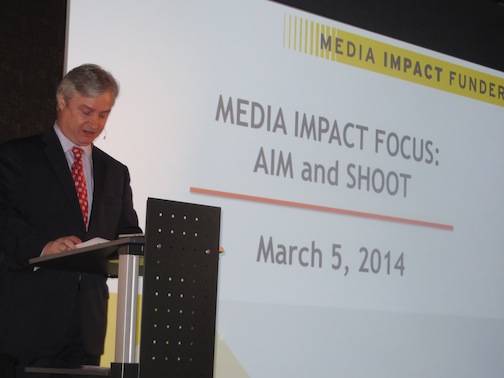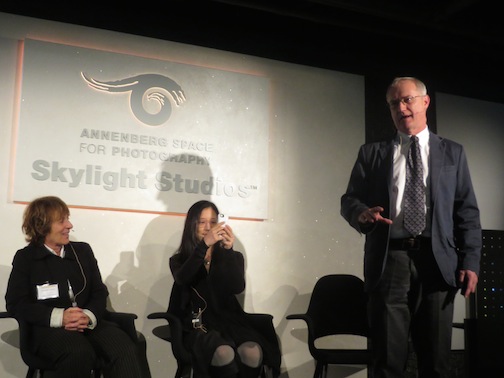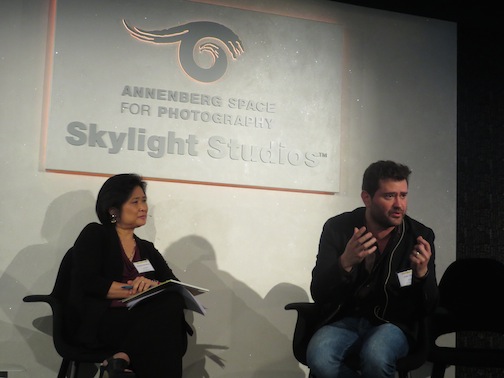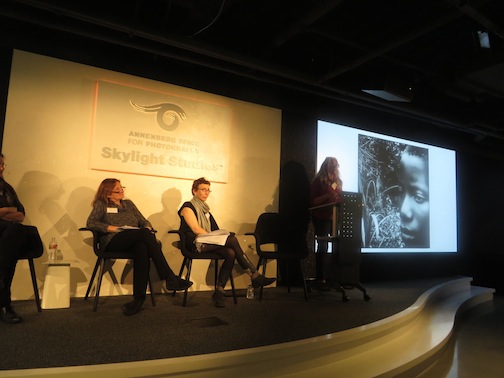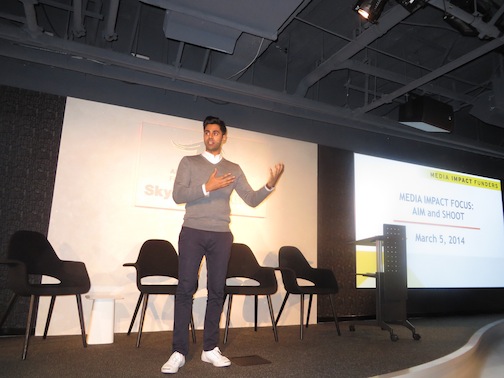
On March 5 we continued the discussion of cutting-edge impact analysis methods we began last November, and added documentary photography to the list of topics covered.
Read the storify from the day.
We heard from leading funders and media makers from the National Geographic Society, Open Society Foundations, Participant Media, and the USC Annenberg School for Communication and Journalism, among others, to learn how philanthropically funded productions are transforming audiences and sparking social change.
_______________
9:00 — Introduction and Welcome
- Vince Stehle, Executive Director, Media Impact Funders
- Leonard Aube, Executive Director, Annenberg Foundation
9:10 — Documentary Impact in Action
- Chad Boettcher, Executive Vice President, Social Action and Advocacy, Participant Media
- Caty Borum Chattoo, Public Affairs Strategist, Participant Media and Creative Director, Center for Media & Social Impact; Executive in Residence, American University
- Shaun MacGillivray, Producer, To the Arctic
- Jim Miller, Executive Director, Brave New Films
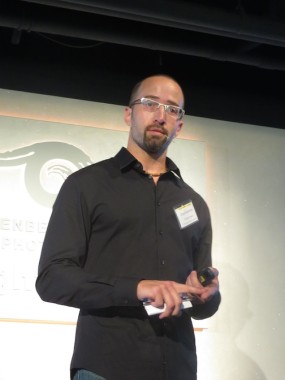 We heard how leading documentary producers are demonstrating the impact of their films. Boettcher demoed the Participant Index, a national survey panel tracking how media spurs action. MacGillivray revealed how his spectacular IMAX journey into one of the planet’s last untouched regions has rallied more than a million viewers to call for environmental protections. The film served as a touchstone for advocates ranging from celebrities to polar explorers, and involved an extraordinary partnership with Coca-Cola to reach a broad audience. Miller reported from the frontlines of Brave New Films’ continuing project to “create media that makes an impact.” Leveraging what they learned through producing effective campaigns around such films as Outfoxed and Wal-Mart: The High Cost of Low Price, Brave New Films’ latest investigative documentary — Unmanned: America’s Drone Wars — harnesses a coalition of nonprofit partners and viewers to change U.S. drone policy.
We heard how leading documentary producers are demonstrating the impact of their films. Boettcher demoed the Participant Index, a national survey panel tracking how media spurs action. MacGillivray revealed how his spectacular IMAX journey into one of the planet’s last untouched regions has rallied more than a million viewers to call for environmental protections. The film served as a touchstone for advocates ranging from celebrities to polar explorers, and involved an extraordinary partnership with Coca-Cola to reach a broad audience. Miller reported from the frontlines of Brave New Films’ continuing project to “create media that makes an impact.” Leveraging what they learned through producing effective campaigns around such films as Outfoxed and Wal-Mart: The High Cost of Low Price, Brave New Films’ latest investigative documentary — Unmanned: America’s Drone Wars — harnesses a coalition of nonprofit partners and viewers to change U.S. drone policy.
Watch the trailer for To the Arctic.
Watch the trailer for Drone Wars
10:10 — Exhibit: The Power of Photography: National Geographic 125 Years
We were fortunate to enjoy a private viewing of the cutting-edge exhibit on display in the Annenberg Space for Photography, which commemorates how photography can explore, educate, inspire, and preserve the world around us. Each visitor experienced the collection differently, as hundreds of photos looped through video walls arrayed throughout the gallery. This dynamic experience celebrates “a simple principle,” says Wallis Annenberg, Chairman of the Board, President and CEO of the Annenberg Foundation, “that we are all stewards of this remarkable planet.”
11:00 — High-Impact Photography Behind the Scenes
- Pat Lanza, Director, Talent & Content, Annenberg Space for Photography
- Dennis Dimick, Executive Editor (Environment), National Geographic Magazine
- Pamela Chen, Senior Photo Editor, National Geographic Magazine
- Sandra Ainslie, Executive Director, The AjA Project
- Nick Beda, Photographer, The Aja Project
- Juan Devis, Vice President, Arts and Culture Programming, KCETLink
We learned more about the exhibition’s creation in this session and learned how the National Geographic Society and the Annenberg Foundation collaborated to develop this state-of-the-art multimedia production that brings the world’s most compelling public interest photography to life. We also focused on the power of photography, as shown by National Geographic photographers, who are shining major spotlights on critical issues — from mineral – fueled conflicts to our melting polar ice.We also explored how else photography is being used to tell meaningful stories that engage communities and have real impact. Ainslie showed what happens when you hand the camera off to participants to document their own experiences — the AjA project uses participatory photography to help refugee and under-served youth reflect on their lives and identities and to become agents of change for their communities. Devis discussed the challenge of communicating photography that is not just representational, but also very conceptual, a commentary on society, history, and the environment. He explored how KCETLink’s Artbound is harnessing video and broadcast to capture complex 21st century photographic projects for new audiences.
1:00 — Emerging Funding Strategies for Photography
- Amy Yenkin, Director, Open Society Foundations Documentary Photography Project
- Susan Meiselas, President, Magnum Cultural Foundation & Photographer
- Emma Raynes, Program Director, Magnum Foundation Emergency Fund
- Sara Terry, Founder and Artistic Director, The Aftermath Project
After lunch, our discussion of photography’s social impact continued, with remarks on promising trends and projects from leading supporters of documentary photography. Despite widespread cutbacks in support for traditional photojournalism, documentary photographers and advocates are finding fresh ways to collaborate and reach target audiences, using analog as well as new media to put images to work for social good.
The Open Society Foundations is the largest funder of documentary photography. Yenkin showed examples of how photography has advanced a core priority, criminal justice reform in the United States. She also addressed the question of impact.
In the face of the breakdown of traditional media infrastructure, the Magnum Foundation is supporting a network of independent international and regional photographers by providing support, training, mentorship and space for innovation within the shifting media terrain. Meiselas and Raynes discussed the role they are playing and projects supported.
Terry presented work from The Aftermath Project, which runs an annual grant competition that supports photographers working on post-conflict stories as a way to spur dialogue about the long-term human costs of these situations. She focused on the visual literacy curriculum that The Aftermath Project has developed in collaboration with Facing History and Ourselves.
2:10 — Office Hours
This session offered attendees a chance to sit down with key presenters to learn more about their projects, or to make time to connect with peers.
3:00 — Impact Next Steps
- Hasan Minhaj, Comic and Host of Stand Up Planet
- Todd Cunningham, Director, Media Impact Project, The Norman Lear Center
- Marty Kaplan, Founding Director, The Norman Lear Center
- Johanna Blakley, Managing Director/Director of Research, The Norman Lear Center
We heard from Minhaj, the host of KCETLink’s edgy new transmedia documentary program, Stand Up Planet, which features comedians from the developing world, tackling some of the toughest global poverty issues through humor. Can comedy break through cultural differences and move viewers to support social change? We heard what inspired Minhaj to take on this unprecedented project, and what the production team has learned so far.
Then, what comes next for media makers and funders seeking to understand how their productions can make change? We heard from the leadership team at the Media Impact Project, which is a new global hub at USC’s Annenberg School jointly funded by the Gates and Knight Foundations devoted to collecting, developing and distributing the smartest approaches and best tools for measuring the impact of media.
Check out the Media Impact Project presentation given by Blakley, Cunningham and Kaplan.
4:15 — Wrap-up
